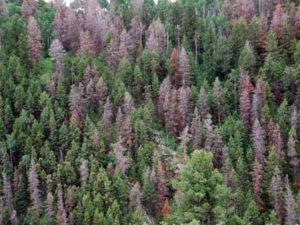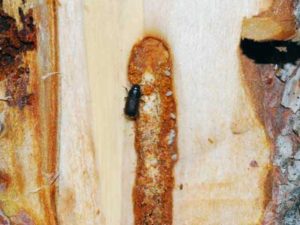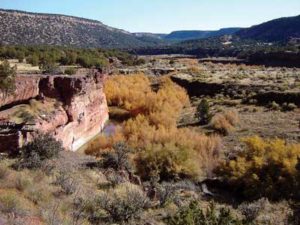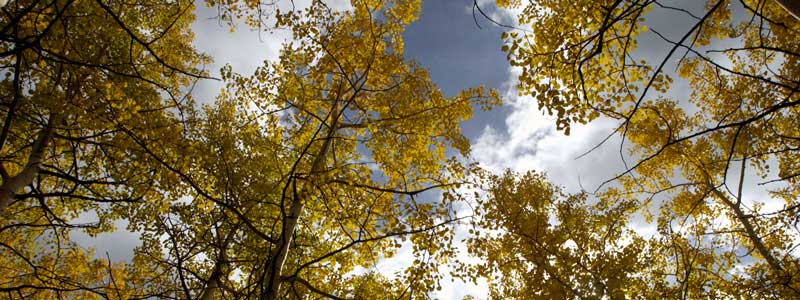The Condition of Colorado’s Forests
Several issues and influences contribute to the current condition of Colorado’s forest resources. Those of primary concern are: trends in forest cover change, insect and disease cycles, expansion of the wildland-urban interface and watershed health.

 Several issues and influences contribute to the current condition of Colorado’s forest resources. Those of primary concern are:
Several issues and influences contribute to the current condition of Colorado’s forest resources. Those of primary concern are:
- Trends in forest cover change
- Insect and disease cycles
- Expansion of the wildland-urban interface and watershed health
Additional issues of note include:
- Threats to the health of the state’s urban and riparian forests
- Implications for Colorado’s air quality based on future forest conditions
Declining Forest Health and Extended Wildfire Seasons
The decline in forest health and increased length of wildfire seasons linked to climate change are pressing issues in Colorado. Forest fragmentation and development also are detrimental to the state’s forests. Additionally, decades of fire suppression have left a legacy of unnaturally dense forests and high fuel buildups in some areas increasing the need to invest in programs that help protect lives, property and vulnerable resources from potentially catastrophic wildfires.
Because much of Colorado’s forest lands are old and unmanaged, they are prone to insect and disease epidemics, and wildfires. Although Colorado’s forests are disturbance-driven and should naturally be characterized by diversity in age and size, past decisions have resulted in forests that are homogenous at a landscape level, making them vulnerable to widespread damage.
Disturbance
Without disturbances to periodically rejuvenate forest stands and ensure a variety of forest types, ages and densities, many of Colorado’s forests have become overly dense and concentrated in older age classes. This lack of diversity, along with intense competition for resources such as water and light, has left many forest stands vulnerable to insect and disease attack, catastrophic wildfire and other types of damage at an inordinately vast scale.
 Bark Beetles
Bark Beetles
In recent years, Colorado’s forests have experienced several large-scale insect infestations, including Ips beetles in the piñon forests of southwestern and southeastern Colorado, mountain pine beetles in northern lodgepole pine forests, and spruce beetles in subalpine forests.
While the mountain pine beetle outbreak has collapsed, spruce beetle are the most widespread and damaging forest insect pest for the fourth consecutive year. In addition, the presence of western balsam bark beetle and root diseases, which are native to subalpine fir forests, has increased during the past two decades.
Area Infested by Mountain Pine Beetle and Spruce Beetle in Colorado, 1996-2015
Urban Forestry
Threats to urban and community forests also are on the rise. Salts used to de-ice roads continue to weaken roadside trees such as maples, lindens and elms. Foresters also are concerned about the invasive emerald ash borer, an exotic pest which has the potential to kill many of the 4 million native and planted ash trees in the state.
 Riparian Forest Threats
Riparian Forest Threats
Tamarisk and other invasive trees such as Russian olive also threaten Colorado’s riparian forests. Although this represents only about 1 percent of the state’s total forested area, these forests provide essential benefits disproportionate to their size and are critical to the livelihood of Colorado’s agricultural communities.
 In recent decades, scientists and land managers have begun to re-emphasize the importance of fire and disturbance in many of Colorado’s forests. But restoring fire as a functioning, natural component of these ecosystems poses several challenges:
In recent decades, scientists and land managers have begun to re-emphasize the importance of fire and disturbance in many of Colorado’s forests. But restoring fire as a functioning, natural component of these ecosystems poses several challenges:
- Tools such as prescribed fire must be used appropriately and with attention to fuel loads and smoke management
- Thinning forest stands in advance of prescribed fire often is necessary to restore proper spacing and distribution across the landscape, but thinning small-diameter trees can be expensive and currently offers little economic return
- The rapid growth of homes and other development in the wildland-urban interface (WUI) poses the additional challenge of trying to manage natural resources while providing for the protection of lives and property
Challenges to Come
In addition to specific current conditions, broader challenges likely will affect Colorado’s forests over the next ten to fifteen years and beyond. Climate change, forest fragmentation and fire suppression will continue to disrupt the state’s forests in many ways.
Management decisions regarding forest health issues are necessarily subjective and require a balance of public and private values. In order to make these decisions in an informed, effective manner, land managers, government leaders and the public must better understand how the interactions between natural and human forces shape our forests and influence their ability to provide a variety of benefits on a sustainable basis.
Although the challenges Colorado’s forests face may be daunting, they are not insurmountable. They do, however, require consensus and political resolve to fix. Ensuring the continuation of the benefits that our forests provide, and that Coloradans depend on, is critical to Colorado’s future.


 Bark Beetles
Bark Beetles
 Riparian Forest Threats
Riparian Forest Threats